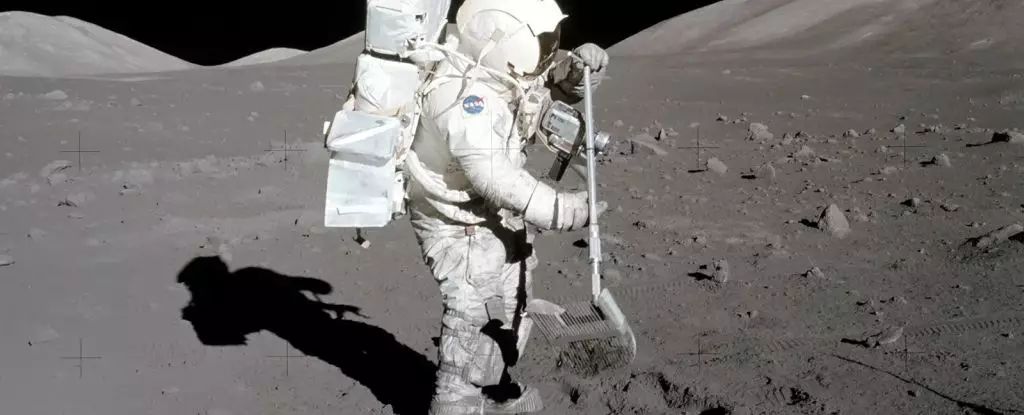

The Moon, our faithful celestial companion, has long been regarded as a timeless entity, thought to have formed shortly after the birth of planet Earth. However, recent research challenges this assumption, suggesting that the Moon is even older than previously believed. According to a study conducted by geologist Jennika Greer and her team at the University of Glasgow, the Moon may be at least 4.46 billion years old, making it a mere 40 million years younger than Earth itself.
One of the greatest mysteries surrounding the Moon is its origin. While numerous theories have been proposed, the prevailing hypothesis is known as the giant impact hypothesis. This theory suggests that billions of years ago, a Mars-sized object collided with a young and freshly-formed Earth, giving rise to an enormous cloud of debris that eventually coalesced into the Moon. However, the exact timeline of this event remains uncertain.
The key to unraveling this enigma lies in the examination of zircon crystals found within lunar samples collected during the Apollo missions. Zircon crystals have a unique property that enables scientists to determine their age accurately. As they form, these crystals incorporate uranium while simultaneously rejecting lead. Over time, the uranium within zircon crystals undergoes radioactive decay, ultimately transforming into lead at a predictable rate. By analyzing the ratio of uranium to lead within zircon crystals, researchers can ascertain the age of the crystals and, consequently, the age of the Moon.
The team led by Philipp Heck from the Field Museum and the University of Chicago emphasized the significance of zircon crystals in establishing a lunar chronology. Heck stated, “These crystals are the oldest known solids that formed after the giant impact. And because we know how old these crystals are, they serve as an anchor for the lunar chronology.” Thus, the newly discovered zircon crystals from Apollo 17 samples provide invaluable evidence to shed light on the Moon’s formation and subsequent evolution.
The zircon crystals analyzed by Greer and her colleagues had to have formed after the Moon’s surface solidified following the lunar magma ocean stage. Prior to this solidification, zircon crystals would have been melted, erasing any chemical signatures they may have contained. By using a technique called atom probe tomography, the researchers were able to meticulously examine the composition of the zircon crystals in question. This process involved sharpening the crystals to a fine point and using lasers to evaporate atoms from that point. Subsequently, a mass spectrometer analyzed the vaporized material, allowing for the measurement of atomic weight and the determination of uranium-to-lead ratios.
The groundbreaking research conducted by Greer and her team revealed that the zircon crystals in the Apollo 17 samples were approximately 4.46 billion years old. This finding not only confirms the Moon’s remarkable age but also provides scientists with essential insights into its formation and subsequent geological history. By refining our understanding of the Moon’s timeline, this research may facilitate the determination of its formation duration and the identification of the exact date of the giant impact event.
Beyond its relevance to lunar studies, the newfound knowledge about the Moon’s age yields significant implications for our understanding of Earth’s history. Greer remarked, “It’s amazing being able to have proof that the rock you’re holding is the oldest bit of the Moon we’ve found so far. It’s an anchor point for so many questions about the Earth.” Indeed, further research into the Moon’s ancient origins may hold the key to discovering more about our own planet’s early development.
In an insightful study conducted by Jennika Greer and her team, the Moon’s age has been estimated to be at least 4.46 billion years old, making it nearly as ancient as Earth itself. By analyzing zircon crystals and their uranium-to-lead ratios, the researchers were able to elucidate the Moon’s origins and contribute to the chronology of lunar history. These remarkable findings open a window into a time long past and may provide crucial insights into the early development of both the Moon and Earth. As we continue to explore the cosmos, the Moon remains an enigmatic partner, guiding us toward a deeper understanding of the universe in which we reside.
Rogue waves have long been a subject of fascination and terror in maritime lore. These…
As the world grapples with public health challenges, especially those posed by infectious diseases, the…
The Sombrero Galaxy, also known as Messier 104, embodies a breathtaking blend of spirals and…
In recent advances in quantum electronics, a groundbreaking discovery leveraging the concept of kink states…
In the intricate tapestry of nature, ice often exists in a delicate balance with liquid…
In an astonishing event that captured global attention, a rogue object from beyond our Solar…
This website uses cookies.